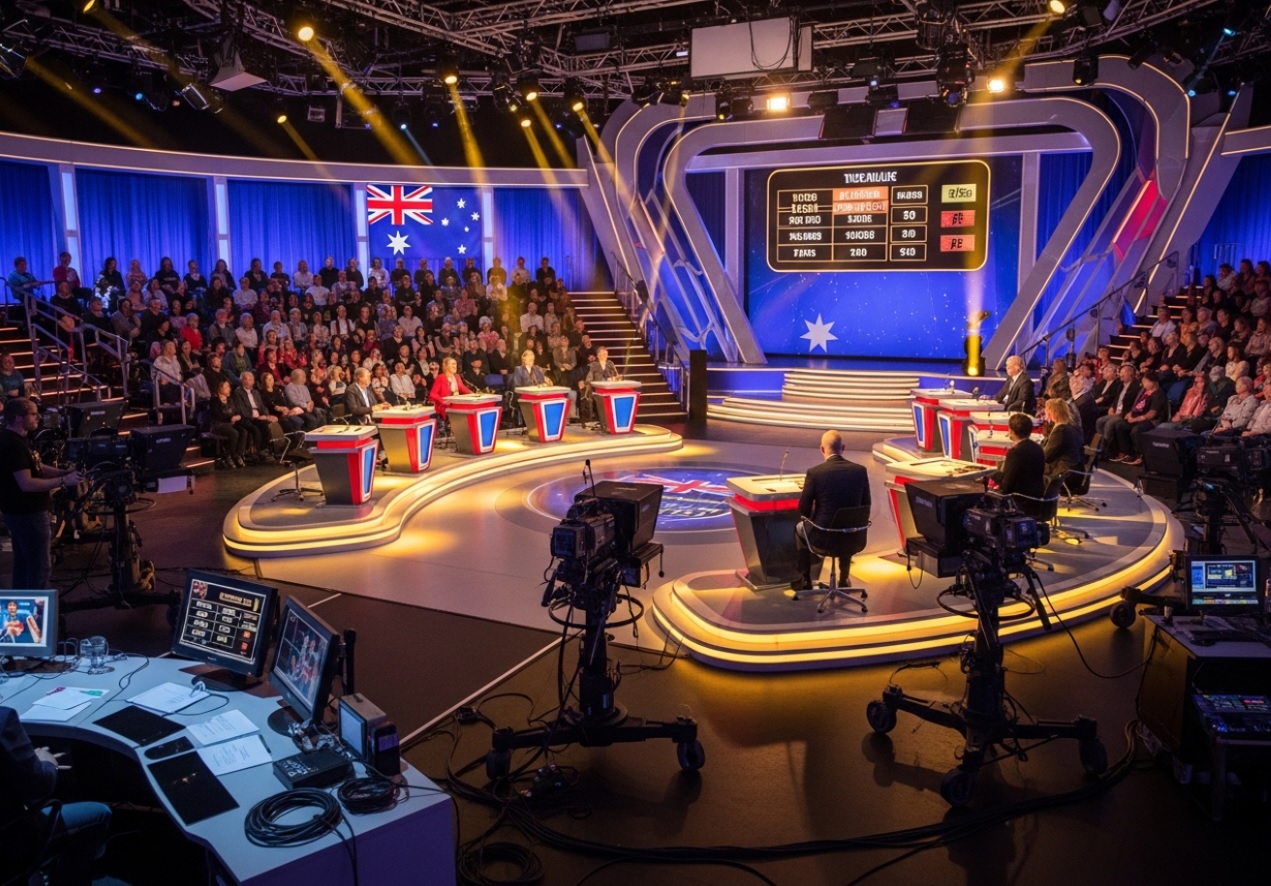Australian Game Shows: The Complete Guide to Quiz, Reality and Entertainment Formats

Australian television has given the world some of its most enduring game show formats, from the wheeling and dealing of Sale of the Century to the high-stakes tension of Deal or No Deal. Since the first game show aired on Australian screens in the 1950s, these programmes have become a cornerstone of local entertainment, capturing the nation's competitive spirit whilst providing audiences with hours of engaging, often hilarious television.
The landscape of Australian game shows has transformed dramatically over seven decades. What started with simple quiz formats in the golden age of television has evolved into a diverse ecosystem of entertainment styles, blending trivia challenges, reality competition elements, comedy panel games and strategic decision-making shows. Today's offerings attract millions of viewers weekly and continue to generate international interest through format sales and adaptations across the globe.
The Golden Age: Establishing Game Show Culture in Australia
Australian television's game show journey began modestly, with Name That Tune becoming the first game show to grace Australian screens in 1956 on TCN9. This marked the beginning of a cultural phenomenon that would shape Australian entertainment for generations to come. Throughout the late 1950s and 1960s, game shows gained momentum as networks recognised their capacity to attract reliable audiences at relatively modest production costs.
The format truly flourished during the 1960s and 1970s, when Australian television began producing local versions of successful international formats. This period established the foundations for what would become a remarkably creative industry. Networks experimented with various formats: panel shows where celebrity guests tested their knowledge, price guessing games where contestants competed for consumer goods, and word games that challenged participants to identify famous faces or guess answers from clues.
Iconic Shows That Defined Generations

Several programmes achieved such prominence that they became intrinsically linked with Australian popular culture. Wheel of Fortune, which aired from 1981 to 2006, entertained audiences through over 5,000 episodes across twenty-five years. Hosted initially by Ernie Sigley and later by John Burgess for an impressive twelve-year stint, the show combined luck and strategy as contestants spun the wheel and solved word puzzles. The format proved so successful that it produced numerous defending champions who returned night after night to accumulate significant winnings.
Sale of the Century stands as perhaps the most legendary Australian game show ever produced. Launching in 1980 on the Nine Network, this innovative programme ran continuously until 2001, becoming a ratings juggernaut and cultural institution. Hosted memorably by Tony Barber for its first eleven years and subsequently by Glenn Ridge, Sale of the Century introduced Australians to the high-stakes drama of haggling for prizes whilst competing in trivia rounds. The show's appeal transcended typical game show audiences, attracting viewers who became invested in contestants' personal journeys and the psychology of their negotiating decisions. Over its two-decade run, the programme distributed more than sixty-five million dollars in prizes, forever changing the scale of what Australian game shows could offer.
Hard Quiz represents a more contemporary approach to the quiz show format. Hosted by comedian Tom Gleeson since 2016, the programme cleverly inverts traditional quiz show conventions by placing the emphasis on comedy alongside knowledge. Contestants nominate specialist subjects, and the dynamic between Gleeson's witty commentary and the contestants' varying levels of expertise creates entertainment value independent of whether the trivia questions are answered correctly. This format proved so successful that it spawned Hard Quiz Kids, extending the concept to younger audiences.
The Comedy Quiz Revolution

Australian audiences have long appreciated blending humour with competitive games. Spicks and Specks, which premiered in 2005 and revived in recent years, transformed the music quiz format into comedy gold. Hosted by Adam Hills with team captains Myf Warhurst and Alan Brough, the programme's appeal lay not in straightforward trivia but in the banter, visual gags and creative games that emerged from music knowledge. Segments like Cover Versions, where contestants drew silent pictures of album artwork, became beloved classics.
Have You Been Paying Attention has carved out its own niche as a topical comedy panel game. Presented by Tom Gleisner on Network 10 since 2013, the show quizzes permanent regulars Ed Kavalee and Sam Pang alongside rotating comedy guests about the week's news events. Rather than pure knowledge recall, the format rewards quick wit, comedic timing and the ability to provide humorous answers alongside correct ones. The show's banter-driven approach won a Logie Award, recognising how successfully it balanced news information with comedy entertainment.
Contemporary Formats and Global Success
Modern Australian game shows have achieved remarkable international success, with formats proving popular across numerous countries. The Chase Australia, which premiered in 2015 on Seven Network, exemplifies this trend. The show pits four contestants against professional quizzers known as Chasers, who attempt to prevent them from reaching the prize pot. The Chasers themselves—including personalities like Brydon Coverdale, Anne Hegerty, Matt Parkinson and Issa Schultz—have become television fixtures, their on-air banter and trivia expertise generating genuine compelling drama as contestants strategise which offers to accept.
Deal or No Deal enjoyed enormous popularity across its original run from 2003 to 2013 on Seven Network, hosted by Andrew O'Keefe. The programme achieved something remarkable in Australian television history by becoming the first international adaptation of the Dutch format Miljoenenjacht. The show's premise—where contestants opened numbered cases whilst negotiating with a mysterious banker who made offers for their case—proved irresistible, regularly outperforming competing shows in ratings. The format's combination of probability calculation, emotional investment and suspenseful decision-making made it compelling regardless of how much trivia knowledge participants possessed. Network 10 revived the format in 2024 with Grant Denyer as host, demonstrating the enduring appeal of the concept.
Mastermind Australia, which returned to SBS in 2019 after a three-decade absence, reinstated the iconic format's reputation for serious, challenging trivia. Hosted by quizmaster Marc Fennell, contestants face two minutes answering questions about their specialist subject, followed by a general knowledge round. The show's intimidating studio setting and rigorously demanding questions created something distinctive in modern Australian television—a show where pure intellectual capability became the primary focus rather than entertainment spectacle.
The Latest Generation of Game Shows

Australian game show production continues to evolve. The Floor, which premiered on Nine Network in April 2025, brought an entirely new format to Australian audiences. Hosted by Rodger Corser, the programme features eighty-one contestants competing on a massive nine-by-nine grid floor, with contestants attempting to expand their territory through timed knowledge duels. This format combines trivia knowledge with spatial strategy, offering visual spectacle alongside mental challenge.
Tipping Point Australia brings a coin-pusher machine mechanic to Australian television, hosted by former tennis champion Todd Woodbridge. Contestants earn counters by answering multiple-choice questions, then insert these counters into the large coin machine, hoping to dislodge other counters that fall into the cash zone. The show perfectly encapsulates modern game show philosophy—combining general knowledge requirements with an element of chance that makes outcomes less predictable than pure trivia shows.
The 1% Club, hosted by American comedian Jim Jefferies on Seven Network since 2023, represented a significant format innovation. Rather than requiring recalled facts or trivia knowledge, the show challenges one hundred contestants to answer questions based on logic, reasoning and common sense. Questions reflect actual statistical data about what percentage of Australians answered correctly, creating a unique competitive dynamic where contestants compete against collective national intelligence rather than simply beating opponents or a machine.
Why Australian Game Shows Matter to Audiences

Game shows occupy a unique position in Australian television culture. Unlike drama series that require sustained narrative attention or reality television that demands emotional investment in characters over months, game shows offer self-contained entertainment where anyone can understand the stakes immediately. A new viewer can watch Deal or No Deal for the first time and grasp the tension instantly. This accessibility, combined with the possibility of watching ordinary Australians win extraordinary amounts of money, creates powerful viewing motivation.
These programmes also function as cultural touchstones. Generations of Australians grew up with particular hosts and formats, creating nostalgic connections that endure decades later. Mentions of iconic moments—a contestant finally solving the Sale of the Century puzzle after weeks of trying, a Deal or No Deal player correctly reading the banker's psychology, a Hard Quiz subject expert being mercilessly mocked by Tom Gleeson—trigger immediate recognition and shared memory among audiences.
The Competitive Trivia Scene Behind the Scenes
Australian game shows have fostered a vibrant competitive quizzing community. Serious trivia enthusiasts participate in regular competitions, quiz bowl events and championship tournaments. Many of the professional Chasers on The Chase Australia emerged from this competitive quizzing scene, proving their expertise through consistent victories and championship titles. Issa Schultz, for instance, has won the Australian Quizzing Championships multiple times and ranks highly in world quizzing competitions, bringing genuine elite-level knowledge to the Chaser role.
This professional quizzing community ensures that modern Australian game shows maintain genuine intellectual rigor. Rather than simply reproducing international formats, producers and hosts can access genuinely accomplished Australian quizzers whose expertise makes competition more meaningful and entertaining. The triangle between broadcast television, professional quizzing competitions and casual audience participation creates a sustainable ecosystem supporting quality game show production.
Looking Forward: The Enduring Appeal of Game Shows

Despite enormous changes to television consumption habits, from streaming services to social media, Australian game shows continue attracting sizeable audiences. Ratings data consistently demonstrates strong viewership for quiz and game show content, suggesting the format's inherent entertainment value transcends technological disruption. The simplicity of the premise—people competing, stakes being determined, winners and losers declared—provides something fundamentally compelling that resonates across generations and viewing platforms.
Future Australian game show development will likely continue blending formats. Game shows incorporating celebrity participants, emotional backstories, dramatic music and lighting effects represent evolution rather than departure from core game show principles. Successful shows will combine genuine competitive stakes with entertainment value, intellectual challenge with accessibility, and celebrity appeal with relatable contestants whom audiences can support.
Australian game shows have evolved from simple quiz programmes into sophisticated entertainment vehicles, yet their fundamental appeal remains unchanged. Whether contestants are spinning wheels, opening cases, answering trivia questions or inserting coins into machines, the format endures because it captures something essential about human nature: our love of competition, our fascination with watching others face challenges, and our delight when ordinary people achieve extraordinary outcomes. As Australian television continues transforming, game shows will almost certainly remain part of the broadcasting landscape, adapted and refreshed but fundamentally unchanged in their power to entertain.